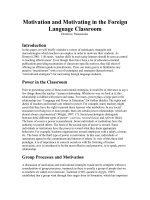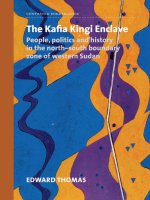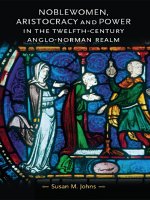kolomoki settlement ceremony and status in the deep south a d 350 to 750 sep 2003
Bạn đang xem bản rút gọn của tài liệu. Xem và tải ngay bản đầy đủ của tài liệu tại đây (3.45 MB, 284 trang )
Kolomoki
Publication of this work has been supported in part by the
Dan Josselyn Memorial Fund
Kolomoki
Settlement, Ceremony, and Status in the
Deep South, a.d. 350 to 750
Thomas J. Pluckhahn
the university of alabama press
Tuscaloosa and London
Copyright © 2003
The University of Alabama Press
Tuscaloosa, Alabama 35487-0380
All rights reserved
Manufactured in the United States of America
Typefaces are AGaramond and Triplex
∞
The paper on which this book is printed meets the minimum requirements of American
National Standard for Information Science–Permanence of Paper for Printed Library Materials,
ANSI Z39.48-1984.
Library of Congress Cataloging-in-Publication Data
Pluckhahn, Thomas J. (Thomas John), 1966–
Kolomoki : settlement, ceremony, and status in the Deep South,
a.d. 350 to 750 / Thomas J. Pluckhahn.
p. cm.
Includes bibliographical references and index.
ISBN 0-8173-1299-4 (cloth : alk. paper) — ISBN 0-8173-5017-9 (pbk. : alk. paper)
1. Kolomoki Mounds State Historic Park (Ga.) 2. Woodland culture—Georgia.
3. Excavations (Archaeology)—Georgia. I. Title.
E78.G3 .P68 2003
975.8′ 901—dc21
2003001799
British Library Cataloguing-in-Publication Data available
Figures and Tables vii
Acknowledgments xiii
1.
An Introduction to Kolomoki 1
2. Putting Kolomoki in Its Place: De¤ning the Temporal,
Ecological, and Cultural Contexts 15
3. Preliminary De¤nition of Activity Areas at
Kolomoki: Summary of Previous Research 47
4. De¤ning Activity Areas at Kolomoki: Results
of Intensive Sampling 91
5. Characterizing Activity Areas at Kolomoki: Results of Test
Excavations and Geophysical Prospection 126
6. Examining a Domestic Activity Area at Kolomoki:
Results of Small Block Excavations 146
7. Kolomoki as a Historical Process 180
Notes 223
References Cited 227
Index 251
Contents
Figures
1.1 Location of Kolomoki and other sites mentioned in the text 2
1.2 The Kolomoki site 3
2.1 Location of Kolomoki with respect to major rivers 32
2.2 Location of Kolomoki with respect to major physiographic
divisions of the Coastal Plain 33
2.3 Large survey and excavation projects within 200 km
of Kolomoki 37
2.4 Early and middle Middle Woodland components within
200 km of Kolomoki 41
2.5 Late Middle and early Late Woodland components within
200 km of Kolomoki 42
2.6 Middle and late Late Woodland components within
200 km of Kolomoki 44
3.1 Valliant’s 1937 map of Kolomoki 50
3.2 Locations of con¤rmed and reported mounds at Kolomoki 52
3.3 Aerial photograph of Kolomoki, 1948 57
3.4 Waring and Sears in Mound D 61
3.5 Excavation of the ceramic cache in Mound D 61
3.6 Excavation of Mound E 65
Figures and Tables
3.7 Excavation of the central burial pit in Mound E 65
3.8 Topographic map of mounds excavated by Fairbanks 70
3.9 Fairbanks’s plan and pro¤le maps of Mound K 71
3.10 Locations of previous studies in off-mound
areas at Kolomoki 74
4.1 Locations of intensive samples 93
4.2 Density of Woodland ceramics in samples 94
4.3 Density of Swift Creek ceramics in samples 96
4.4 Density of Weeden Island Red ceramics in samples 97
4.5 Density of Carrabelle Incised/Punctate ceramics in samples 98
4.6 Density of other Weeden Island ceramics in samples 100
4.7 Density of Napier ceramics in samples 101
4.8 Density of ®aked stone in samples 102
4.9 Density of Coastal Plain chert in samples 103
4.10 Density of quartz in samples 105
4.11 Density of quartzite in samples 106
4.12 Density of Ridge and Valley chert in samples 107
4.13 Locations of activity areas 109
4.14 Ceramic density by activity area 116
4.15 Ceramic ubiquity by activity area 117
4.16 Lithic density by activity area 118
4.17 Lithic ubiquity by activity area 119
5.1 Locations of test units 127
5.2 Locations of geophysical prospection grids 137
6.1 Locations of excavation blocks 147
6.2 Locations of features in Block A 149
6.3 Feature 57 during initial stages of excavation 152
6.4 Feature 57 during ¤nal stages of excavation 153
viii figures and tables
6.5 Contour map of the structure in Block A 154
6.6 Densities of ceramics and ®aked stone in Block A 159
6.7 Ground stone pendants from Block A and vicinity 164
6.8 Locations of features in Block B 167
6.9 Pro¤le of Block B excavation units 170
6.10 Densities of ceramics and ®aked stone in Block B 174
6.11 Locations of features in Block C 176
7.1 Kolomoki I phase settlement and community plan 188
7.2 Kolomoki II phase settlement and community plan 199
7.3 Kolomoki III phase settlement and community plan 209
7.4 Possible higher status ceramics from Kolomoki III and
IV phase contexts 210
7.5 Kolomoki IV phase settlement and community plan 214
Ta b l e s
2.1 Proportions of ceramic types in test units by phase 18
2.2 Summary of proposed ceramic phases for Kolomoki 20
2.3 Recent radiocarbon dates from Kolomoki 21
2.4 Ceramic types represented at Fairchild’s Landing and
Hare’s Landing 23
2.5 Rim treatments represented in a sample of plain sherds
from Fairchild’s Landing 25
2.6 Summary of rim treatments and vessel forms represented in
test unit assemblages by phase 26
2.7 Vessel forms represented in a sample of plain sherds with
unmodi¤ed rims from Fairchild’s Landing 27
2.8 Summary of PP/K types in test units by phase 29
3.1 Chronology of events related to the history and archaeology
of Kolomoki 48
3.2 Ceramic totals for mound assemblages 54
figures and tables ix
3.3 Summary of rim treatments and vessel forms represented in
mound assemblages 55
3.4 Ceramic totals for assemblages from Sears’s excavations in
the North Ravines 75
3.5 Summary of rim treatments and vessel forms in assemblages
from Sears’s excavations in the North Ravines 76
3.6 Ceramic totals for assemblages from Sears’s excavations in
the Northwest Area and Central Plaza 79
3.7 Summary of rim treatments and vessel forms in assemblages from
Sears’s excavations in the Northwest Area and Central Plaza 80
3.8 Ceramic totals for assemblages from investigations in
off-mound areas 84
4.1 Ceramic totals for the pooled assemblages from samples by
activity area 112
4.2 Ceramic density and ubiquity values for the pooled
assemblages from samples by activity area 113
4.3 Lithic totals for the pooled assemblages from samples by
activity area 114
4.4 Lithic density and ubiquity values for the pooled assemblages
from samples by activity area 115
4.5 Proportion of diagnostic ceramic categories for the pooled
assemblages from samples by activity area 121
5.1 Summary data for features in test units 129
5.2 Ceramic totals for test units 131
5.3 Lithic totals for test units 133
5.4 Miscellaneous artifacts from test units 134
5.5 Summary of macro-botanical remains from test units 135
5.6 Summary of faunal remains from test units 136
5.7 Comparison of artifact density and feature density in
test units 138
6.1 Summary data for features in Block A 150
x figures and tables
6.2 Ceramic totals for Block A 158
6.3 Summary of rim treatments and vessel forms in the assemblage
from Block A 160
6.4 Flaked stone totals for Block A 161
6.5 Miscellaneous artifacts from Block A 162
6.6 Summary of faunal remains from Block A 165
6.7 Summary of macro-botanical remains of edible and medicinal
plants from Block A 166
6.8 Summary data for features in Block B 168
6.9 Ceramic totals for Block B 171
6.10 Summary of rim treatments and vessel forms in the assemblage
from Block B 172
6.11 Flaked stone totals for Block B 173
6.12 Miscellaneous artifacts from Block B 175
6.13 Summary of macro-botanical remains from Block B 175
6.14 Summary data for features in Block C 176
6.15 Ceramic totals for Block C 177
6.16 Flaked stone totals for Block C 177
7.1 Summary of macro-botanical remains of edible and medicinal
plants from recent work at Kolomoki 186
7.2 Population estimates for the Kolomoki I and II phases 191
7.3 Estimated labor requirements for mound construction
by phase 193
7.4 Population estimates for the Kolomoki III and IV phases 210
figures and tables xi
I am indebted to many people for their contributions to this book. First and
foremost, I must thank my major professor, Steve Kowalewski, for his unwavering
support and enthusiasm. We never succeeded in getting Steve to set foot in a
square hole, but he participated in virtually every other stage of the project, from
proposal writing to cutting transit lines and back-¤lling. It would be dif¤cult to
overstate Steve’s contribution to this research or, for that matter, to Georgia ar-
chaeology in general.
I also extend my thanks to the other members of my committee, including
David Hally, Charles Hudson, Ervan Garrison, and Elizabeth Reitz. Thanks as
well to the unof¤cial sixth member of the committee, Mark Williams, for his
continued reassurance that this was a signi¤cant and worthy endeavor.
I am grateful to the National Geographic Society for funding my research.
Additional support was provided by the LAMAR Institute and by a Joshua Laerm
Memorial Award from the Georgia Museum of Natural History. Institutional
support was provided by the University of Georgia and the State Parks and His-
toric Sites Division of the Georgia Department of Natural Resources.
It has been many years since academic research was conducted at a Georgia
State Park, and I am grateful to a number of individuals at the Georgia Depart-
ment of Natural Resources and Kolomoki Mounds State Historic Park for their
assistance in bringing the project to fruition. In particular, I thank David Crass,
Billy Townsend, and Chip Morgan for supporting my research. At Kolomoki,
my work was greatly facilitated by park superintendents Eric Bentley and Larry
Blankenship, as well as park personnel Billy Adams, Matt Bruner, Judy Moore,
and Sid Sewell. Permission to investigate the privately owned portions of the site
was generously granted by Buddy Jenkins and Mike and Meredith Whitehead.
Over the course of three ¤eld seasons, I have had the pleasure of working
Acknowledgments
with a number of ¤ne students, and I thank them all for their efforts. The 1998
crew members, each of whom worked at Kolomoki for a week, included Will
Chambers, Erica Dougherty, Natalie Faulkner, Heather Hayes, Josuah Hendrick,
Donna Howard, Ryan Hurd, Kim Lewis, Carrie McAlister, Katie Price, Ben
Richardson, Debbie Rose, Sandy Sekman, Ben Sellers, Chris Swindell, Brian
Tibbles, and Caroline Wardlaw.
The 2000 ¤eld crew members, who stayed with me the entire summer, deserve
special thanks for much of the dirty work of cutting survey lines and excavating
shovel tests. This small group included Tiffany Andrews, James Mauldin, Silas
Mullis, and Dennis Wardlaw.
In 2001, we ran a short ¤eld school in shallow geophysics, followed by a longer
session in archaeological ¤eld methods. The students for the short session in-
cluded Laina Davis, Jennifer Hart, and Megan Risse. The 2001 ¤eld school par-
ticipants, who provided exceptional service in the excavation of the house, con-
sisted of Danielle James, David Krizan, Iva Lee Lane, Susannah Lee, Carmen
Lovvorn, and Julie Ordelt.
Three of these students—Danielle James, James Mauldin, and Silas Mullis—
worked with me as interns after their ¤eld school sessions. Their work greatly
facilitated artifact analysis and data processing.
Each ¤eld season, we extended an invitation to the general public to work with
us at Kolomoki. The response was overwhelming, and the volunteers who con-
tributed their time are too numerous to mention. I thank them all for their efforts
and enthusiasm.
A number of friends and colleagues lent their assistance to the ¤eldwork. My
deepest thanks go to fellow graduate students Verónica Pérez Rodríguez and Matt
Compton for their help in directing the 2000 and 2001 ¤eld schools (respec-
tively). I also thank Nina Šerman and Jill Wesselman for their assistance with the
2001 geophysics ¤eld school. I am greatly indebted to those colleagues who vol-
unteered their labor, including Nichole Gillis, Bill Jurgelski, Heather Mauldin,
Melissa Memory, Betsy Shirk, Keith Stephenson, Victor Thompson, Jamie Wag-
goner, and Jared Wood.
Mary Theresa Bonhage-Freund conducted the analysis of the macro-plant re-
mains from my excavations. Analysis of the faunal assemblage was completed
primarily by Matt Compton, with additional assistance from Tiffany Andrews
and Barnet Pavao-Zuckerman.
Other colleagues have assisted me by granting access to data. I thank Dennis
Blanton, Ken Johnson, Jerald Ledbetter, Frankie Snow, and Karl Steinen for lend-
ing me source material that greatly aided my interpretation of the site. I am par-
ticularly grateful to Chris Trowell for generously sharing the results of his exten-
xiv ack nowle dgme n ts
sive research on the history of Kolomoki. Thanks also to Richard Vernon and the
National Park Service for the loan of collections and documentation relating to
Fairbanks’s work at Kolomoki.
My compilation of site ¤les data was abetted by the personnel of the agencies
that oversee the data in Alabama, Florida, and Georgia. My thanks to Eugene
Futato, Michelle Cremer, and Mark Williams for their assistance.
Tom Gresham and Chad Braley offered me gainful employment at crucial
points throughout my career as a graduate student. I thank them for their pa-
tience and support, as well as for the occasional loan of equipment for my re-
search. I must also thank Charlotte Blume for her assistance in guiding me
through the vagaries of academic bureaucracy.
The book bene¤tted greatly from comments and suggestions of Tim Pauketat
and Frank Schnell.
Last, but perhaps most important, I thank my family—especially my parents—
for helping me through the occasional hard times.
ack nowledgments xv
Kolomoki
Not so, however the Mercier Mound. Impelled by some strange impulse, or
necessity, its builders have made it a structure destined to stand till the end of
time. . . . By whom, when, and for what this massive work was thrown up, are
questions never to be answered by vague conjecture or inde¤nite speculation.
“The Indian Mounds in Early County,”
Early County News, June 27, 1882
Kolomoki—formerly known as the Mercier Mounds—is one of the most impres-
sive archaeological sites in the southeastern United States (Figure 1.1). The site,
located in the lower Chattahoochee Valley of southwestern Georgia, includes at
least nine mounds (Figure 1.2). The largest of these (Mound A) rises some 56 ft
(17 m) from the broad, high terrace on which the site is located. From the rec-
tangular summit of Mound A, one can observe the string of smaller mounds (B,
H, G, F, and E) that forms an arc to the south. Mound C, to the north of Mound
A, frames the opposite side of this open area. Another mound (D) stands promi-
nently near the center of the site, almost directly west of Mound A. Historical
accounts point to the former existence of several other mounds and a large
earthen wall or enclosure.
The number and magnitude of its earthworks make Kolomoki impressive,
but these have also been a source of confusion. The site was originally thought to
date to the Mississippian period (ca. a.d. 1000–1500), when agricultural chief-
doms built tall platform mounds and palisaded villages throughout the South-
east. It is now generally agreed that the primary occupation at Kolomoki dates
to the Middle and Late Woodland periods, before the era of the Mississippian
chiefdoms.
1
An Introduction to Kolomoki
1.1 Location of Kolomoki and other sites mentioned in the text
1.2 The Kolomoki site
Kolomoki and a few other Middle and Late Woodland mound sites confound
simple categorizations of Woodland and Mississippian, tribe and chiefdom, egali-
tarian and ranked, and simple and complex societies. This book presents a his-
tory of Kolomoki from its founding at roughly a.d. 350 to its eventual abandon-
ment at around a.d. 750, with particular attention to Woodland period economy
and settlement. I have contextualized this within broader anthropological con-
cerns regarding the nature of middle-range societies, especially the role of ritual
and ceremony in the development of status differentiation among such social for-
mations. However, the most fundamental concern is to illuminate the historical
development of an important, but long misunderstood, site for both the archaeo-
logical community and the lay public.
Before delving into the research, it is important to provide some context, be-
ginning with a description of what has become known, among some archaeolo-
gists, as “the Kolomoki problem.” I then consider some of the challenges that
archaeologists have confronted in attempting to interpret middle-range societies
such as Kolomoki. Finally, I detail the theoretical framework and research strategy
with which I intend to address some of the research issues that I have raised.
“The Kolomoki Problem”
Kolomoki was ¤rst described in print more than a century ago (Jones 1873;
Pickett 1851; White 1854). The site was subsequently investigated by several
archaeologists and antiquarians loosely af¤liated with the Smithsonian Institution
(McKinley 1873; Palmer 1884). These early investigations, despite being poorly
controlled and inadequately reported, nevertheless described important features
that were subsequently lost to agriculture and erosion.
Contemporary archaeological work at Kolomoki began in the late 1930s under
the direction of Charles Fairbanks and Robert Wauchope (Fairbanks 1940a,
1940b, 1941a, 1941b, 1946). More intensive excavations were initiated about a
decade later by William Sears, who excavated six of the mounds and conducted
limited testing in the presumed village area (Sears 1950, 1951a, 1951b, 1953a,
1953b, 1956). Mounds D and E proved to contain elaborate mortuary complexes
that included Hopewellian artifacts such as copper ear spools, meteoric iron or-
naments, and mica disks. Mounds F and H, on the other hand, each consisted of
small platforms later covered by conically shaped capping layers. Sears admitted
to some confusion regarding the structure and purpose of Mounds B and C, but
the former apparently resulted from the piling of earth (perhaps sweepings from
the plaza) around large posts. Owing to its large size, only minimal investigation
was conducted on Mound A.
4 chapter 1
Sears correctly identi¤ed the dominant ceramic varieties at Kolomoki as the
Swift Creek and Weeden Island types, which had been de¤ned by other research-
ers working in the region (Jennings and Fairbanks 1939; Kelly and Smith 1975;
Milanich 1994; Willey 1945, 1949; Willey and Woodbury 1942). However,
Sears declined to accept the growing consensus that these were Woodland pottery
types. He instead inverted the ceramic chronology to force the dominant occu-
pation into the Early Mississippian period, around a.d. 1200 (Sears 1956). Sears’s
error became known to some archaeologists as “the Kolomoki problem” (Trowell
1998).
With the bene¤t of hindsight, it is dif¤cult for us to fully comprehend the
reasons for Sears’s mistake. However, we must bear in mind that his work at Kolo-
moki came near the climax of development of the cultural historical paradigm,
a time in which Southeastern archaeologists were working to establish macro-
regional chronologies based on broad similarities among sites (Ford and Willey
1941; Grif¤n 1952; Willey and Sabloff 1980). Kolomoki, with its large, ®at-
topped mound and elaborate mortuary ceramics, clearly did not ¤t the mold that
had been cast for the Woodland period in the Southeast. Constrained by the
normative paradigm of his day, Sears found it easier to believe that the recently
established ceramic chronology for the area was faulty than to accept the notion
that the broad cultural historical sequences for the Southeast could be in error.
The reluctance to attribute Mound A, as well as some of the elaborate ceramics
in Mounds D and E, to a Woodland period society was not limited to Sears. Jesse
Jennings (1938:1–2), while recognizing the Woodland period occupation of the
site as the most substantial, believed that Mound A must have been the product
of a Mississippian culture. Ripley Bullen was also reluctant to attribute the site to
a Woodland society (letter of Bullen to Joseph Caldwell, April 15, 1954, Univer-
sity of Georgia Laboratory of Archaeology). James Grif¤n, Sears’s academic ad-
visor at the University of Michigan, confessed to some confusion regarding the
proposed chronology and dismay at the contradiction of established ceramic se-
quences, but he nevertheless ultimately concurred with Sears (letter of Grif¤n to
Sears, December 15, 1950, University of Michigan Museum of Anthropology
[UMMA]; Grif¤n 1984). Charles Fairbanks was receptive to Sears’s conclusions
(Fairbanks 1956:11–12), although he was also one of the ¤rst to question his
interpretations in print (letter of Fairbanks to James Grif¤n, February 2, 1942,
UMMA; Fairbanks 1952, 1955).
Many other prominent archaeologists of the day were unconvinced by Sears’s
interpretation of Kolomoki as a Mississippian site. Gordon Willey, Joseph Cald-
well, and John Goggin objected early and strongly to Sears’s chronology, albeit
primarily in personal correspondence (letter of Grif¤n to Sears, November 21,
an introduction to kolomoki 5
1950, UMMA; letter of Sears to Grif¤n, December 8, 1950, UMMA; Caldwell
1958).
1
The de¤nitive rebuttal to Sears’s chronology came from Stephen Williams
(1958), who reviewed the ¤nal report for American Antiquity: “The confusion
arising from an equation of Temple Mound to Mississippian is obvious. . . . To
think of Kolomoki as ‘Mature Mississippi’ because of its temple mound was the
false step that led Sears’s chronology astray.” Sears himself admitted his error
shortly before his death, effectively laying the controversy to rest (Sears 1992).
Over the course of the past 50 years, a great deal of corroborating evidence
has ¤rmly established that the dominant ceramic types at Kolomoki date to the
Middle and Late Woodland periods ( Jenkins 1978; Knight and Mistovich 1984;
Milanich 2002; Smith 1977; Stephenson et al. 2002). In addition, Woodland
platform mounds, while not common, occur with greater regularity than was
previously thought by Southeastern archaeologists (Brose 1988; Jefferies 1994;
Knight 1990, 2001; Mainfort 1986, 1988a, 1988b; Pluckhahn 1996). Although
the identi¤cation of Kolomoki as a Woodland period ceremonial center is today
widely accepted, the site has remained enigmatic.
2
Very basic questions have, until
now, gone largely unanswered: How big is the site? What was the economy? How
much of the occupation was permanent and domestic in function? What were
Swift Creek and Weeden Island houses like? The lack of basic knowledge is due
to the limited scope and poor documentation of previous work in off-mound
portions of the site, little follow-up research since the 1950s, and until very re-
cently the absence of survey and excavation in the surrounding area.
Kolomoki and the Classi¤cation of Middle-Range Societies
Archaeologists in the Midwest and Southeast have long differed in their interpre-
tation of the level of cultural complexity that is apparent in the material remains
of the Middle and Late Woodland periods (compare, for example, Anderson
1998; Bender 1985a, 1985b; Braun 1979, 1986; Dancey and Pacheco 1997;
Milanich et al. 1997; Seeman 1979; Smith 1986, 1992; Tainter 1977, 1983).
Most now agree that social ranking existed during the Woodland period, but
they disagree widely over whether such differences were achieved or inherited
(McElrath et al. 2000:4), and thus they argue about whether Woodland societies
should be considered tribes or chiefdoms.
Consistent with his interpretation of the site as a Mississippian period mound
center, Sears (1956) borrowed heavily from ethnographic accounts of the late
seventeenth-century Natchez to describe the prehistoric inhabitants of Kolomoki
as a chiefdom. He envisioned the site as a densely occupied village of around
2,000 people, supported by corn agriculture. In later accounts, Sears (1968) de-
scribed the site as the administrative center of a state-level society.
6 chapter 1









